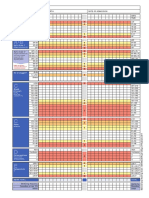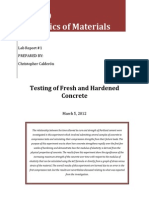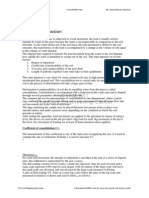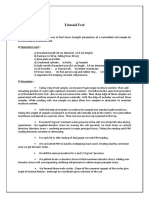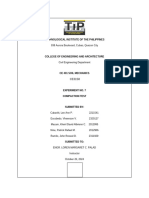Compaction Test
Uploaded by
Arjun MulluCompaction Test
Uploaded by
Arjun MulluPage | 1
FACULTY OF ENGINEERING AND BUILT ENVIRONMENT
EXPERIMENT: COMPACTION TEST
MEHREEN ZEENAT HEERAH SCM-019211
MOHAMMAD ARSHAD HOSSANY SCM-020570
NIHAAD LAULLOO SCM-014963
GROUP NO. : GROUP 2
SUBJECT NAME : SOIL MECHANICS 2
COURSE CODE : ECG 4313
LECTURERS NAME : MISS JAMILAH BINTI JAADIL
DATE OF EXPERIMENT : 08. 07. 2014
DATE OF SUBMISSION : 16. 07. 2014
Page | 2
Table of Contents
Purpose ............................................................................................................................................ 3
Introduction ..................................................................................................................................... 3
Standard Reference ......................................................................................................................... 3
Significance..................................................................................................................................... 3
Equipment ....................................................................................................................................... 4
Procedures ....................................................................................................................................... 4
Calculations..................................................................................................................................... 5
Results and Calculations ................................................................................................................. 6
Graph............................................................................................................................................... 7
Discussion ....................................................................................................................................... 7
Conclusion ...................................................................................................................................... 8
References ....................................................................................................................................... 9
Appendix ......................................................................................................................................... 9
Page | 3
Purpose
This experiment was performed to determine the relationship between the moisture content and
the dry density of a sample of soil for a specified compactive effort.
Introduction
This experiment is also known as the Proctor test. The Proctor compaction test is a laboratory
method of experimentally determining the optimal moisture content at which a given soil type
will become most dense and achieve its maximum dry density. There are different ways to
compact the soil on site. For example kneading compactors, tamping, vibration plates and static
load compaction. But in this experiment we use the tamping or impact compaction. Compaction
is a dense state which is achieved through the reduction of the air voids in the soil with little or
no reduction in the water content. Compaction of the soil is very important before starting the
construction as it decreases the risk of future settlement, it increases the shear strength of the soil
and decrease the permeability also.
Standard Reference
ASTM D 698 Standard Test Methods for Laboratory Compaction
Characteristics of Soil Using Standard Effort (12, 400 ft-lbs/ft (600 KN-m/m)
ASTM D 1557- Standard Test Methods for Laboratory Compaction Characteristics of
Soil Using Modified Effort (56, 000 ft-lbs/ ft (2700 KN-m/m)
Significance
Mechanical compaction is considered to be the most common and cheapest way of stabilizing the
soil. One of the most important things for a geotechnical engineer is to check that performance
and analysis of the compacted soil are meeting the performance of the design specifications. The
required density and water content are usually stated in the design specifications. Usually, when
increasing the soil density, the other engineering properties, like strength, stiffness, resistance to
shrinkage and imperviousness of the soil will also improve. The optimum water is the water
content that results in the greatest density for a specified compactive effort.
Page | 4
Equipment
1. Moulds
2. Manual rammer
3. Balance
4. Drying oven
5. Mixing pan
6. Trowel
7. Moisture cans
8. Graduated cylinder
9. Straight edge
10. Ruler
11. Sieve
Procedures
1. The weight of the mould (mould + base + side screw) was measured by using the
electronic balance.
2. The internal diameter and height was measured by using a ruler.
3. Afterwards grease was applied on the sides of the mould and on the collar.
4. 5 mixing pans and 10 moisture cans were prepared (2 containers per sample).
5. The weight of each moisture cans together with lid was measured with the help of
electronic balance.
6. The soil was sieved.
7. 3kg of loose soil was then measured.
8. The required amount of distilled water was measured according to the assumed water
content.
9. The soil was mixed thoroughly with the water by using both hands.
10. After having mixed it completely, the soil was divided into 3 sections.
11. The first section of the soil was put up to
2
of the mould.
12. With the help of the rammer, the soil was compacted by 25 blows.
13. The second layer of soil is added and rammered 25 more times
Page | 5
14. Then the collar was assembled and the screws were tightened.
15. The last layer of soil was added and was rammered for 25 times again.
16. Then the collar was removed and the soil was levered using a straight edge.
17. The mould containing the compacted soil together with the base and side screws were
weighed.
18. Then a small portion of soil at the top was taken and placed in the moisture can.
19. Afterwards the mould is turned upside down and a small portion of soil was taken at the
bottom also and placed in another moisture can.
20. Steps 5 to 19 were repeated for each assumed water content.
21. The moisture cans were weighed.
22. Then these moisture cans were placed in the oven to dry.
23. After 24hr the moisture cans were removed from the oven and was allowed to cool for 10
minutes.
24. Then the weight of the moisture cans was noted.
Calculations
Page | 6
Results and Calculations
Water Content Determination:
Water content 9% 12% 15% 18% 21%
Compacted Soil Top Bottom Top Bottom Top Bottom Top Bottom Top Bottom
M
C
= Mass of
empty can+lid (g)
33.0 32.9 33.3 33.0 33.2 32.0 32.6 32.4 32.6 33.0
M
CMS
= Mass of
can, lid and moist
soil (g)
45.2 41.5 50.6 47.2 49.9 46.2 43.3 43.1 62.7 67.1
M
CDS
= Mass of
can, lid and dry
soil (g)
44.3 40.8 48.7 45.8 47.8 44.4 41.8 41.5 57.2 61.2
M
S
= Mass of soil
solids (g)
11.3 7.9 15.4 12.8 14.6 12.4 9.2 9.1 23.6 28.2
M
W
= Mass of
pure water (g)
0.9 0.7 1.9 1.4 2.1 1.8 1.5 1.6 5.5 5.9
W = Water
content (w%)
7.96 8.86 12.34 10.94 14.38 14.52 16.30 17.39 23.31 20.92
Average water
content (w%)
8.41 11.64 14.45 16.85 22.12
Density Determination:
Compacted Soil Sample no. 1 2 3 4 5
w = Assumed water content, w% 9 12 15 18 21
Actual average water content, w% 8.41 11.64 14.45 16.85 22.12
Mass of compacted soil and mold (g) 5800 6850 5850 5950 6200
Mass of mold (g) 4400 5050 4450 4400 4450
Wet mass of soil in mold (g) 1400 1800 1400 1550 1750
Diameter of mold (cm) 10.2 10.4 10.1 10.2 10.1
Height of mold (cm) 11.6 11.5 11.7 11.6 11.7
Volume of mold (cm
3
) 947.9 976.9 937.4 947.9 937.4
Wet density, 1.477 1.843 1.493 1.635 1.867
Dry density,
d
1.362 1.650 1.304 1.399 1.529
Page | 7
Graph
Graph of dry density against water content
Discussion
The Proctor test is carried out to determine the relationship between the moisture content and the
dry density of a soil sample. From the graph plotted above, we can see that the maximum dry
density, 1.65 g/cm
3
, occurred when the water content is 11.64%. One can also see that the
assumed water content is almost the same the theoretical one. This slight difference has occurred
due to some small errors. For example, due to the presence of fans or because when pouring the
water, some of it was splashed.
Furthermore, we can conclude from the shape of the graph that experiment for the 15% and 21%
are not correct. The actual result should be like the red graph below.
1.2
1.25
1.3
1.35
1.4
1.45
1.5
1.55
1.6
1.65
1.7
1.75
1.8
8 10 12 14 16 18 20 22 24
D
r
y
d
e
n
s
i
t
y
(
g
/
c
m
)
Water content (w%)
Dry density vs Water content
Page | 8
Some errors that might have occurred during the experiment:
1. Parallax error when taking the measurement of the mould or when reading the measuring
cylinder.
2. The presence of fan which can make the soil become dry more quickly.
3. The water and the soil were not mixed properly and uniformly.
4. Loss of water due to splashing of water.
5. The soil was not rammered uniformly which can result for some areas not being well
compacted.
6. The mould was not completely filled due to presence of air voids. So, the volume of soil
will not be correct.
Conclusion
The proctor test is very important in the construction field. It helps to lower the permeability of
the soil and to increase its shear stress. From the results obtained above we can conclude that the
dry density of soil is dependent of its water content. But the relationship is not a linear one. We
can also conclude that the optimum water content is found at the maximum dry density of the
soil.
1
1.05
1.1
1.15
1.2
1.25
1.3
1.35
1.4
1.45
1.5
1.55
1.6
1.65
1.7
1.75
1.8
8 10 12 14 16 18 20 22 24
D
r
y
d
e
n
s
i
t
y
(
g
/
c
m
)
Water content (%)
Experimental results
Theoretical results
Page | 9
References
http://www.uic.edu/classes/cemm/cemmlab/Experiment%209-Compaction.pdf
Appendix
Figure 1. Sample soil Figure 2. Weighing moisture can
Figure 3. Rammering the soil Figure 4. Levelling the soil
You might also like
- Hourglass Workout Program by Luisagiuliet 276% (21)Hourglass Workout Program by Luisagiuliet 251 pages
- The Hold Me Tight Workbook - Dr. Sue Johnson100% (16)The Hold Me Tight Workbook - Dr. Sue Johnson187 pages
- Read People Like A Book by Patrick King-Edited62% (66)Read People Like A Book by Patrick King-Edited12 pages
- Livingood, Blake - Livingood Daily Your 21-Day Guide To Experience Real Health77% (13)Livingood, Blake - Livingood Daily Your 21-Day Guide To Experience Real Health260 pages
- COSMIC CONSCIOUSNESS OF HUMANITY - PROBLEMS OF NEW COSMOGONY (V.P.Kaznacheev,. Л. V. Trofimov.)94% (212)COSMIC CONSCIOUSNESS OF HUMANITY - PROBLEMS OF NEW COSMOGONY (V.P.Kaznacheev,. Л. V. Trofimov.)212 pages
- Donald Trump & Jeffrey Epstein Rape Lawsuit and Affidavits83% (1016)Donald Trump & Jeffrey Epstein Rape Lawsuit and Affidavits13 pages
- The 36 Questions That Lead To Love - The New York Times94% (34)The 36 Questions That Lead To Love - The New York Times3 pages
- The 36 Questions That Lead To Love - The New York Times95% (21)The 36 Questions That Lead To Love - The New York Times3 pages
- Jeffrey Epstein39s Little Black Book Unredacted PDF75% (12)Jeffrey Epstein39s Little Black Book Unredacted PDF95 pages
- NEWS2 Chart 3 - NEWS Observation Chart - 0 PDFNo ratings yetNEWS2 Chart 3 - NEWS Observation Chart - 0 PDF1 page
- The 4 Hour Workweek, Expanded and Updated by Timothy Ferriss - Excerpt23% (954)The 4 Hour Workweek, Expanded and Updated by Timothy Ferriss - Excerpt38 pages
- Lab 6: Specific Gravity of Sand and SoilNo ratings yetLab 6: Specific Gravity of Sand and Soil16 pages
- Dokumen - Tips Cec 103 Workshop Technology 1No ratings yetDokumen - Tips Cec 103 Workshop Technology 1128 pages
- Falling Head Permeability Test Lab ReportNo ratings yetFalling Head Permeability Test Lab Report7 pages
- CVE 230. Lab Report 1 (Fresh and Hardened Concrete) .No ratings yetCVE 230. Lab Report 1 (Fresh and Hardened Concrete) .4 pages
- Shrinkage Limit + Liquid Limit by Penetrator MethodNo ratings yetShrinkage Limit + Liquid Limit by Penetrator Method8 pages
- CEE 346L - Geotechnical Engineering I Lab: Title: Particle Size Analysis by Use of A HydrometerNo ratings yetCEE 346L - Geotechnical Engineering I Lab: Title: Particle Size Analysis by Use of A Hydrometer9 pages
- Determination of Field Density by Core Cutter Method100% (1)Determination of Field Density by Core Cutter Method3 pages
- Experimentno. 1 Determinationof State of Flow and Critical Depth in Open ChannelNo ratings yetExperimentno. 1 Determinationof State of Flow and Critical Depth in Open Channel5 pages
- Fluid Mechanics Lab Laboratory Manual: Dev Bhoomi Institute Chakrata Road, Navgaoun Manduwala, Uttarakhand100% (1)Fluid Mechanics Lab Laboratory Manual: Dev Bhoomi Institute Chakrata Road, Navgaoun Manduwala, Uttarakhand29 pages
- Year 4 Geotechnical-Engineering Lab ReportNo ratings yetYear 4 Geotechnical-Engineering Lab Report18 pages
- 5 One Dimensional Flow of Water Through SoilsNo ratings yet5 One Dimensional Flow of Water Through Soils28 pages
- Lab Manual 2 Rectangular and Triangular NotchesNo ratings yetLab Manual 2 Rectangular and Triangular Notches8 pages
- Constant Falling Head Permeability Test PDFNo ratings yetConstant Falling Head Permeability Test PDF14 pages
- Use of Glass Powder For Soil StabilisationNo ratings yetUse of Glass Powder For Soil Stabilisation75 pages
- Lecture Note Course Code-Bce 303 Geotechnical Engineering-INo ratings yetLecture Note Course Code-Bce 303 Geotechnical Engineering-I127 pages
- A Technical Report On Soil Compaction TestNo ratings yetA Technical Report On Soil Compaction Test13 pages
- Fifa 'Rejects England & Scotland Request To Wear Poppies On Armbands'No ratings yetFifa 'Rejects England & Scotland Request To Wear Poppies On Armbands'3 pages
- Preliminary Treatment Process of Waste WaNo ratings yetPreliminary Treatment Process of Waste Wa9 pages
- TGV Cinemas 2 TGV Tickets +1 Large Popcorn + 2 Small Soft DrinksNo ratings yetTGV Cinemas 2 TGV Tickets +1 Large Popcorn + 2 Small Soft Drinks1 page
- Faculty of Engineering and The Built Enviroment: Subject: Project Management and Appraisal (Ecv4413) Tutorial 1No ratings yetFaculty of Engineering and The Built Enviroment: Subject: Project Management and Appraisal (Ecv4413) Tutorial 13 pages
- 2017-18 IUT Admission Test Math B TypeSOL With SolutionNo ratings yet2017-18 IUT Admission Test Math B TypeSOL With Solution5 pages
- Running Head: The Theory of Reasoned Action 1: Marketing Consumer BehaviorNo ratings yetRunning Head: The Theory of Reasoned Action 1: Marketing Consumer Behavior9 pages
- PROPOSED CONSTRUCTION OF 2 CLASSROOMS AT NDEGE PRIMARY SCHOOLNo ratings yetPROPOSED CONSTRUCTION OF 2 CLASSROOMS AT NDEGE PRIMARY SCHOOL3 pages
- Sample - Salmon Market (2022 - 2027) - Mordor IntelligenceNo ratings yetSample - Salmon Market (2022 - 2027) - Mordor Intelligence23 pages
- Kenneth Foner - Getting A Quick Fix On ComonadsNo ratings yetKenneth Foner - Getting A Quick Fix On Comonads12 pages
- Livingood, Blake - Livingood Daily Your 21-Day Guide To Experience Real HealthLivingood, Blake - Livingood Daily Your 21-Day Guide To Experience Real Health
- COSMIC CONSCIOUSNESS OF HUMANITY - PROBLEMS OF NEW COSMOGONY (V.P.Kaznacheev,. Л. V. Trofimov.)COSMIC CONSCIOUSNESS OF HUMANITY - PROBLEMS OF NEW COSMOGONY (V.P.Kaznacheev,. Л. V. Trofimov.)
- Donald Trump & Jeffrey Epstein Rape Lawsuit and AffidavitsDonald Trump & Jeffrey Epstein Rape Lawsuit and Affidavits
- The 36 Questions That Lead To Love - The New York TimesThe 36 Questions That Lead To Love - The New York Times
- The 36 Questions That Lead To Love - The New York TimesThe 36 Questions That Lead To Love - The New York Times
- Jeffrey Epstein39s Little Black Book Unredacted PDFJeffrey Epstein39s Little Black Book Unredacted PDF
- The 4 Hour Workweek, Expanded and Updated by Timothy Ferriss - ExcerptThe 4 Hour Workweek, Expanded and Updated by Timothy Ferriss - Excerpt
- CVE 230. Lab Report 1 (Fresh and Hardened Concrete) .CVE 230. Lab Report 1 (Fresh and Hardened Concrete) .
- Shrinkage Limit + Liquid Limit by Penetrator MethodShrinkage Limit + Liquid Limit by Penetrator Method
- CEE 346L - Geotechnical Engineering I Lab: Title: Particle Size Analysis by Use of A HydrometerCEE 346L - Geotechnical Engineering I Lab: Title: Particle Size Analysis by Use of A Hydrometer
- Determination of Field Density by Core Cutter MethodDetermination of Field Density by Core Cutter Method
- Experimentno. 1 Determinationof State of Flow and Critical Depth in Open ChannelExperimentno. 1 Determinationof State of Flow and Critical Depth in Open Channel
- Fluid Mechanics Lab Laboratory Manual: Dev Bhoomi Institute Chakrata Road, Navgaoun Manduwala, UttarakhandFluid Mechanics Lab Laboratory Manual: Dev Bhoomi Institute Chakrata Road, Navgaoun Manduwala, Uttarakhand
- Lecture Note Course Code-Bce 303 Geotechnical Engineering-ILecture Note Course Code-Bce 303 Geotechnical Engineering-I
- Fifa 'Rejects England & Scotland Request To Wear Poppies On Armbands'Fifa 'Rejects England & Scotland Request To Wear Poppies On Armbands'
- TGV Cinemas 2 TGV Tickets +1 Large Popcorn + 2 Small Soft DrinksTGV Cinemas 2 TGV Tickets +1 Large Popcorn + 2 Small Soft Drinks
- Faculty of Engineering and The Built Enviroment: Subject: Project Management and Appraisal (Ecv4413) Tutorial 1Faculty of Engineering and The Built Enviroment: Subject: Project Management and Appraisal (Ecv4413) Tutorial 1
- 2017-18 IUT Admission Test Math B TypeSOL With Solution2017-18 IUT Admission Test Math B TypeSOL With Solution
- Running Head: The Theory of Reasoned Action 1: Marketing Consumer BehaviorRunning Head: The Theory of Reasoned Action 1: Marketing Consumer Behavior
- PROPOSED CONSTRUCTION OF 2 CLASSROOMS AT NDEGE PRIMARY SCHOOLPROPOSED CONSTRUCTION OF 2 CLASSROOMS AT NDEGE PRIMARY SCHOOL
- Sample - Salmon Market (2022 - 2027) - Mordor IntelligenceSample - Salmon Market (2022 - 2027) - Mordor Intelligence




























